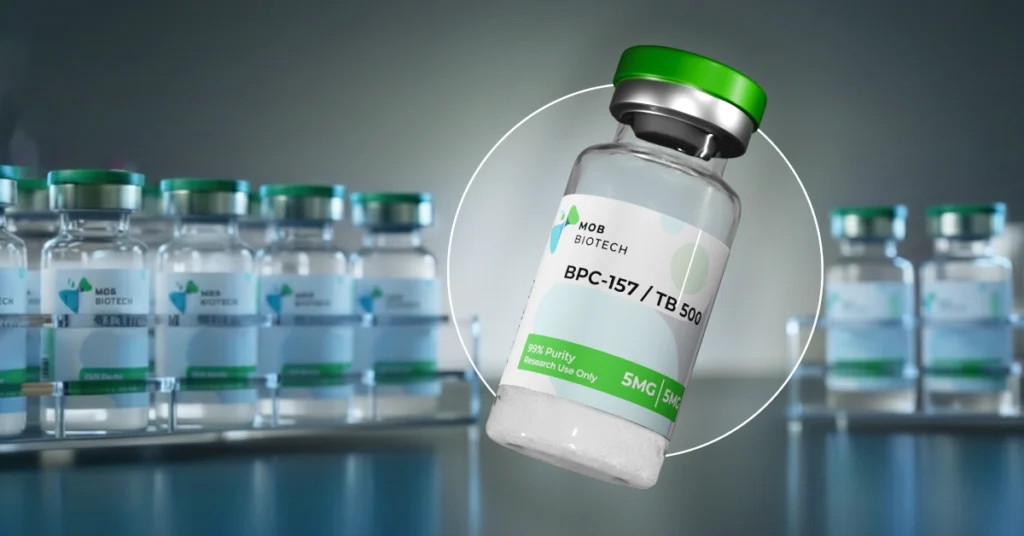Look, the world of scientific discovery, especially in complex fields like regeneration and tissue modeling, has moved aggressively past the naive belief that one single tool is enough to solve a systemic problem; instead, true progress demands the strategic deployment of complementary assets to achieve a greater, non-linear effect. And the BPC-157/TB-500 blend has not just become an example of this synergy—it is the definitive benchmark. If your research protocols are still focused on these peptides individually, you are actively missing out on a powerful, immediate, combined approach that the most innovative, top-tier labs have already been leveraging for months. Stop debating the merits of one versus the other. Because the profound difference here isn’t merely what each peptide accomplishes alone, but precisely how their combined action—driving both local cytoprotection (BPC-157) and broad, deep migratory support (TB-500)—creates an inherently more robust and comprehensive model for tissue repair, cellular protection, and inflammatory modulation, a potent synergy you must harness for serious inquiry.
What Is the BPC-157 / TB-500 Blend?
The BPC-157 / TB-500 blend combines two distinct, yet highly synergistic, peptide fragments. BPC-157 (Body Protection Compound-157) is a peptide fragment derived from a natural protein found in the stomach. It is an extremely stable compound with a wide range of documented actions, primarily related to tissue healing and cytoprotection. TB-500, a synthetic version of the naturally occurring protein thymosin beta-4, is an actin-regulating peptide. It plays a critical role in cell migration, differentiation, and tissue repair.
The power of this blend lies in its complementary actions. BPC-157 is often studied for its ability to stabilize cellular pathways and promote healing in various tissues, including the gastrointestinal tract, tendons, and muscles. Its mechanisms involve growth factor modulation and angiogenesis. TB-500, on the other hand, is a master regulator of actin, a protein fundamental to the cytoskeleton and cellular movement. It helps to organize the actin filaments, promoting cell migration to sites of injury and facilitating the formation of new blood vessels. When these two are combined, their mechanisms don’t just add up; they multiply, offering a more complete and powerful model for studying tissue recovery and cellular response to stress.
What Research Models Are Exploring with the BPC-157 / TB-500 Blend?
The blend’s synergistic action makes it an ideal tool for complex research models where a multi-pathway approach is required. Its applications span a wide array of biological systems, providing a comprehensive platform for discovery.
✅ Comprehensive Tissue Repair & Regeneration: Investigations into accelerated healing of ligaments, tendons, and muscles. Models are often used to explore how the combined action of growth factor modulation (BPC-157) and cell migration (TB-500) influences the speed and quality of tissue recovery.
✅ Systemic Inflammatory Modulation: Studies exploring the blend’s effects on systemic and localized inflammation. Researchers are keen to understand how this combination can regulate inflammatory pathways and provide cytoprotection in different tissues and organs.
✅ Vascular and Endothelial Function: Research into the blend’s ability to promote angiogenesis (formation of new blood vessels) and improve blood flow to injured areas, which is crucial for nutrient delivery and waste removal during the healing process.
✅ Gut-Brain Axis & Gastrointestinal Health: Investigations into BPC-157’s well-documented effects on the GI tract, complemented by TB-500’s general regenerative properties. This provides a powerful model for understanding the connections between gut health and systemic well-being.
These areas of inquiry highlight the blend’s remarkable utility, enabling researchers to conduct more sophisticated, multi-layered studies on cellular function and tissue resilience.
Why Top Researchers Include It in Their Protocols
There’s a reason you see the BPC-157/TB-500 blend consistently featured in the ordering history of high-volume research labs. It’s not a secret, but a quiet consensus among those who demand the best from their compounds. Serious researchers know that to produce robust, publishable data, you can’t rely on half-measures. They have moved beyond the idea of using one compound when two, working in concert, can provide a more complete and powerful solution.
The BPC-157/TB-500 blend has become a workhorse in peptide research. While individual peptides often grab the headlines, this combination is what’s quietly driving breakthroughs in labs across the country. The most effective researchers don’t just use BPC-157 or TB-500; they use the blend to achieve more comprehensive results. It’s an approach that separates good labs from great ones.
What to Look for When Ordering the BPC-157 / TB-500 Blend
The integrity of your research is only as strong as the purity of your compounds. When sourcing a blend like BPC-157/TB-500, verification is not just a suggestion—it’s a requirement. The complexity of a blend means there are more opportunities for error, so you must choose a supplier who provides absolute confidence in their product.
Demand a supplier that provides:
- Comprehensive CoA (Certificate of Analysis) Verification: A transparent, detailed document confirming the identity, purity, and concentration of both peptides in the blend.
- Independent HPLC and Mass Spec Testing: Third-party lab results that verify the molecular structure and purity of both components, ensuring there are no unwanted contaminants.
- US-Based Shipping and Operations: This guarantees a reliable and fast supply chain, minimizing delays and ensuring the highest standards of quality control.
- Transparent Sourcing: A clear chain of custody from production to your lab, building trust and confidence in the product’s origin.
- Rewards Program and Account Tools: Efficient systems that streamline your procurement process and reward your loyalty, allowing you to focus on your work.
At MOB Biotech, these are the standards we live by. We believe in providing the highest quality, independently verified compounds, because the facts of our quality speak for themselves.
Why Some Labs Still Overlook It (and Why That’s a Mistake)
We aren’t here to convince everyone. Our mission is to support the labs and researchers who are committed to pushing the boundaries of what is possible. However, it’s worth considering why some still overlook the synergistic power of the BPC-157/TB-500 blend. They might be operating under a mindset that single-compound studies are sufficient, or they may be hesitant to invest in a multi-component approach.
For those labs, this is a costly and significant mistake. By not leveraging the combined power of these two peptides, they are missing out on the opportunity to model more complete and effective outcomes for tissue repair, cellular protection, and inflammation. The fear of loss in research is real—the loss of valuable time, the loss of a competitive edge, and the loss of a chance to make a truly novel discovery. By clinging to single-peptide protocols, these labs are missing out on the full picture that others are already seeing.
Where the BPC-157 / TB-500 Blend Fits in the Research Landscape
The BPC-157/TB-500 blend is positioned as a foundational tool for a variety of advanced research models. Its ability to act on multiple fronts makes it a prime candidate for complex, multi-faceted inquiries.
📌 Tissue Repair & Recovery: The gold standard for models focused on accelerated healing of injuries to ligaments, tendons, and muscle tissue.
📌 Cellular Protection: A powerful tool for investigating how to protect cells from stress, damage, and inflammation.
📌 Vascular Health: Unlocking new avenues for research into angiogenesis and its role in improving blood flow to damaged tissue.
📌 Anti-inflammatory Mechanisms: Ideal for studies exploring systemic and localized inflammatory responses, offering a more complete solution than single compounds.
For researchers building comprehensive protocols, this blend is often the core of their approach. It can be further complemented with other compounds, such as CJC-1295 for models that incorporate growth hormone release into recovery, or with AOD 9604 for models that examine the intersection of tissue repair and lipid metabolism.
Final Word on the BPC-157 / TB-500 Blend
The BPC-157/TB-500 blend is more than just a combination of peptides; it is a synergistic tool that offers a new standard for research into tissue repair and cellular health. Its proven efficacy and complementary actions make it an indispensable asset for any serious laboratory. Don’t let your research be limited by outdated, single-pathway protocols.
Explore batch-tested BPC-157 / TB-500 blend at MOB Biotech and ensure your research is built on a foundation of confidence and quality.
🧬 US-Based. CoA-Backed. Rewards on every purchase.
👉 Explore the BPC-157 / TB-500 Blend at MOB Biotech

